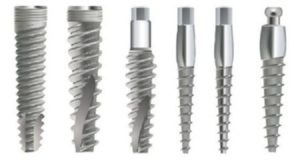When approaching implantology, the first step is to seek information and understand the budget.
Among the various cost items, the dental implant is indicated, but few indicate in detail that the dental implant is not a single block, but consists of three different components.
The parts of a dental implant
It can happen that you are faced with quotes with very different costs. The cost detail compared to the parts of a dental implant can in this sense be a key to reading.
By dental implant in the dental field is meant a single component and that is the screw, while commonly the patient by dental implant means the set of all the components that restore the entire lost tooth. To restore a tooth, at least 4 components are needed:
- Dental implant (shaped like a screw)
- Abutment or MUA (which is the connection system between the dental implant and the crown)
- Crown
- Joining screws, necessary to fix the various components.
Esistono altre componenti che vengono utilizzate provvisoriamente, come ad esempio le viti di guarigione.
We at Sanident in Milan, when we resort to implantology to replace a lost tooth, we analyze the specific case and choose the models of the various components based on the characteristics that best meet the clinical needs.
Carefully selecting every single component means increasing the chances of the intervention being successful and lasting over time.
There are also monobloc dental implants with screw and abutments to compose a single piece, but now their use is very limited.
Characteristics of all parts of a dental implant
Dental implant (also fixture)
The dental implant is the component that is inserted into the bone and effectively replaces the root of the tooth. An important process that affects this screw-shaped component is that of osseointegration, that is, the integration between bone and titanium screw useful to ensure the stability of the entire implant.
Returning to the theme of customization, choosing a screw that adapts to the patient’s anatomy means considering the following conditions:
- bone quantity and quality
- position
- thickness of the gums
- various
Based on the above characteristics, the dentist specialized in implantology will choose the screw for length, inclination, etc. Experience in this field of application is fundamental, because choosing the right implant means knowing how to evaluate the patient’s clinical condition.
Abutment
The abutment (or the MUA, a more sophisticated version of the abutment), also called stump, is the component on which the crown is applied. As with the implant, the abutments may also be different depending on the particular anatomy of the patient. For example, when a screw is inserted inclined in the bone it is important that the abutment is angled to make the implants parallel to each other.
Crown
The crown is the “visible” part of the new tooth and also in this case it is a component that can be adapted to the specific needs of the patient.
The crown can be of different materials and depending on the material have more or less high costs.
The crown can be made in:
- resin
- multiple layered materials (e.g. metal-ceramic or metal-composite)
- zirconia
- lithium disilicate
- other new generation materials (such as peek).
Resin
Resin is the cheapest material, it is usually used in implantology for temporary prostheses. Some materials are an evolution of the resin: more resistant and with a better aesthetic result, they are also used for long-lasting temporary prostheses.
Composite metal or ceramic
On the other hand, composite metal or ceramic metal prostheses exploit the properties of two different materials.
For the composite metal crown there is a composite coated metal prosthesis, in this case the strength and elasticity typical of the metal are combined with the aesthetic rendering of the composite.
For ceramic metal, on the other hand, the coating of the prosthesis is in white ceramic, in this case we will have crowns with a better aesthetic result.
Zirconia
Zirconia is a material widely used for prostheses because its characteristics make it a good candidate both for restoring the function and aesthetics of the tooth. The prosthesis can be either monolithic, or entirely of zirconia, or layered, with a coating that can be ceramic.
Lithium disilicate
The lithium disilicate prosthesis is the one with the best aesthetic result; its color, very similar to that of natural teeth, lasts over time and does not undergo variations. Among the cons, however, there is its fragility, being pure ceramic.
As it is easy to imagine, reading this article, the variables that affect the choice of a dental implant can be manifold. Finding the right combination of all the elements will guarantee the success of the implant surgery to the patient.
Relying on a dental center of excellence, like ours forimplantology in Milan means being able to count on an accurate planning of the intervention, a phase in which the dentist can evaluate the choice of all the parts of a dental implant responding to the real needs of each individual patient.
Remember, each case is different. There is no best material, there is always the best solution for a particular patient. Share your needs with the dentist and you will see that he will advise you on the best way to restore function and smile!



















